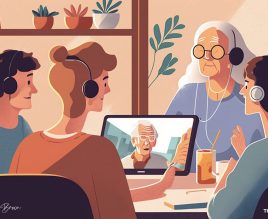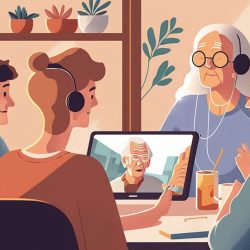Table of Contents
ToggleThe rapid expansion of Robotics & Assistive Technology for Older Adults signifies a transformative era in healthcare. This burgeoning field employs the integration of sophisticated robotic systems and innovative assistive devices, aiming to enhance the quality of life for seniors. From facilitating daily tasks to providing interactive companionship and advanced healthcare monitoring, assistive technology for older adults has proven instrumental in fostering independence, safety, and improved health outcomes.
This fascinating interplay of technology and gerontology could redefine our approach to elder care, positioning it at the vanguard of a more compassionate, efficient, and inclusive future for aging populations worldwide.
Assistive Technology for Adults’ Daily Living
Assistive technology, no longer a thing of futuristic sci-fi, is a reality for many older adults today. It represents the confluence of digital transformation and an aging population, offering tools and services that significantly improve the quality of life. Whether it’s through improving physical mobility or enhancing communication, these technological innovations are progressively breaking down barriers for the elderly, and we’ll explore more on this topic in the sections to follow.

IoT in Aging: Smart Home Solutions
Imagine a home that caters to your every need as you age. Thanks to the Internet of Things (IoT), this “what if” scenario is now a reality for many. IoT has enabled the development of smart homes designed with older adults in mind, and these intelligent living spaces are revolutionizing the concept of aging gracefully.
Smart homes integrate devices like automated thermostats, security systems, and appliances, making daily tasks less daunting for seniors. For instance, a voice command can switch off lights or lock doors, reducing the risk of falls or other accidents. Similarly, automated medication dispensers can remind residents to take their medicines on time, reducing the chances of missed doses. These small but critical changes ensure an older adult can maintain their independence while enjoying a safe living environment.
More recent developments have seen the emergence of AI-assisted smart home solutions. These use AI algorithms to learn and adapt to the individual’s routines, alerting caregivers if there are anomalies, such as missed meals or decreased activity. This smart interaction between humans and their environment demonstrates how IoT has become an integral part of aging, promoting safety and comfort for seniors.
Wearable Devices for Health Monitoring
The rise of wearable technology is another significant stride in empowering older adults through digital transformation. These devices are not merely fitness trackers for the tech-savvy; they’ve evolved into essential health monitoring tools that can make a profound difference in elderly care.
Wearable devices can track vital signs like heart rate, blood pressure, and even blood sugar levels, allowing for real-time health monitoring. This data empowers the wearer and their healthcare provider to spot potential health issues early, leading to faster response times and, often, better outcomes. Recent advancements have seen wearables equipped with fall detection technology, instantly alerting family members or caregivers in case of an emergency.
Beyond physical health monitoring, wearable technology also addresses mental health needs. Some devices provide cognitive exercises to keep the mind sharp, while others offer meditation and stress-management programs. Some even integrate with telehealth services, enabling mental health professionals to provide remote support for those who may need it.
In essence, wearable technology embodies the transformative power of digital innovation, providing a lifeline, a health monitor, and a personal aid for older adults. The result is a more proactive approach to health and wellness, demonstrating how digital transformation can genuinely empower seniors in managing their health.
Robotics for Enhanced Quality of Life
Stepping into a realm once thought to be solely in the territory of science fiction, robotics is now a key player in enhancing the quality of life for seniors. Offering a new dimension to assistive technology, robots provide physical assistance, offer companionship, and even perform tasks around the home. Let’s delve into how these high-tech helpers are transforming the aging experience, bringing a new level of independence and companionship to older adults.

Robotic Companions for Social Interaction
The prospect of loneliness and isolation often looms large for older adults. However, the digital transformation has offered a unique solution: robotic companions. These artificial intelligence-powered robots act as companions, engaging seniors in social interaction and stimulating cognitive functions.
Robotic companions, such as the popular Paro therapeutic robot designed as a cuddly seal, provide comfort and have proven successful in reducing anxiety and improving mood among seniors, particularly those with dementia. Another example, the ElliQ robot, offers interactive engagement by suggesting activities, keeping appointments, and even facilitating video calls with loved ones.
It’s not merely about having a conversation partner. These robots can tell stories, play games, and stimulate reminiscence, thereby fostering a strong emotional connection. Moreover, their ability to learn and adapt to individual personalities and preferences makes the interaction more personal and fulfilling. While robotic companions can’t replace human interaction, they can certainly supplement it, offering comfort and companionship, reducing feelings of loneliness, and contributing to overall mental well-being.
Robotics in Mobility and Physical Assistance
One of the most profound ways robotics is improving life for seniors is through enhanced mobility and physical assistance. Robotic aids like exoskeletons can help seniors regain mobility, and automated wheelchairs offer more freedom of movement. Then there are robotic prosthetics, giving new life to those who may have lost limbs. On a smaller scale, robots are assisting with everyday tasks, easing the physical strain on seniors.
From robotic vacuum cleaners to devices that help with cooking, the home environment has become more manageable.Perhaps the most promising development is in robotic caregivers, like Toyota’s Robina, who can help with tasks ranging from fetching objects to basic house cleaning. While these robotic caregivers are still in the early stages, they offer a glimpse into a future where seniors can enjoy a greater level of independence and safety at home.
Telehealth Services for Seniors
In the face of the digital revolution, telehealth services have emerged as a powerful tool for delivering healthcare to seniors. By eliminating geographical barriers, telehealth brings medical services and support to the comfort of one’s home, making it easier for older adults to receive the care they need. This shift is not only convenient but also vital in maintaining health and independence as one ages.
Remote Health Monitoring
Telehealth has made remote health monitoring possible, offering a breakthrough in managing chronic conditions prevalent in older adults. Using digital devices and platforms, patients can record vital statistics like heart rate, blood sugar levels, and blood pressure at home. This data is then transmitted to healthcare professionals who can monitor these stats in real-time and make treatment adjustments as necessary.
Notably, this system allows for early detection of potential health risks, allowing timely intervention. It also gives seniors a more active role in their healthcare, which can lead to increased adherence to treatment plans and better overall health outcomes. Beyond its practical implications, remote health monitoring represents a new paradigm in healthcare, one where distance and mobility challenges are no longer barriers to receiving excellent care.
Virtual Consultations and Support
Virtual consultations and support represent one of the most powerful applications of telehealth, particularly for seniors. Through video or voice calls, seniors can connect with healthcare professionals without leaving their homes, making it easier for them to access the care they need.
This technology is not just for doctor’s appointments. Virtual consultations can extend to physical therapy, mental health support, and even social services. Moreover, this technology enables caregivers and family members to be more involved in the senior’s care, even if they can’t be physically present. Looking forward, we can expect further advancements in this area. For instance, the integration of AI could lead to more personalized virtual care, while the use of VR could make these consultations even more immersive and interactive.
AI-Powered Assistive Technology for Older Adults
Artificial Intelligence (AI) is increasingly finding its way into assistive devices for seniors, significantly improving their ability to live independently. With its ability to learn and adapt, AI is powering innovations that provide cognitive assistance, enhance communication, and promote safety. Let’s explore the exciting realm of AI-driven devices and how they are redefining aging.
AI in Cognitive Assistance
Cognitive impairment, often a consequence of aging, can pose significant challenges. Enter AI-driven cognitive assistance devices – an innovative solution that aids seniors in maintaining cognitive functions and independence. These devices come in various forms, from apps that improve memory and attention to smart speakers that provide verbal reminders for tasks or medications.
What sets these devices apart is their learning capability. They can adapt to individual patterns, learning to provide timely reminders for routine activities or appointments. Some even come with brain-training games designed to stimulate cognitive functions, helping delay the onset of cognitive decline.
For dementia patients, cognitive assistance devices are even more critical. Some products can recognize when the user is struggling with daily tasks, providing step-by-step verbal instructions to guide them. Others can track a user’s location, ensuring their safety while allowing caregivers some peace of mind. AI in cognitive assistance offers a powerful tool to support seniors’ cognitive health, empowering them to maintain their independence for longer.
AI-Driven Communication Devices
Effective communication is fundamental to well-being, yet it’s a challenge many older adults face due to hearing loss or cognitive decline. AI-driven communication devices provide a solution, enabling seniors to stay connected with their loved ones and caregivers.

Such devices range from AI-powered hearing aids that adapt to the user’s environment to voice-activated smart home devices allowing hands-free communication. These technologies empower seniors to overcome communication barriers, enhancing their social interaction and independence.
One revolutionary device in this field is the AI-powered speech aid. These devices can interpret unclear speech caused by conditions like stroke or Parkinson’s disease, converting it into clear, understandable language. This innovation is a game-changer, enabling those who have lost their ability to speak clearly to communicate effectively once again.
Real-Life Examples and Case Studies
To truly appreciate the impact of digital transformation on elderly care, let’s examine real-life examples and case studies. These stories provide a glimpse into the everyday lives of seniors benefiting from smart home technology, robotics, and telehealth, showcasing the profound effects of these innovations.
A Senior Benefiting from Smart Home Technology
Meet Susan, an 80-year-old living independently thanks to smart home technology. From voice-activated light controls reducing her risk of falls, to a smart refrigerator that reminds her when she’s low on groceries, digital innovation has transformed her home into a safe, comfortable environment.
An automated medication dispenser ensures she never misses her pills, and her smartwatch alerts her children if she falls or if her vital signs show anything unusual. With these intelligent devices, Susan maintains her independence and enjoys a quality of life she never thought possible in her advanced years.
Robotics in Rehabilitation for an Older Adult
Consider John, a 70-year-old stroke survivor. After his stroke, John struggled with mobility, but a robotic exoskeleton transformed his rehabilitation. This robotic aid allowed him to participate in intensive physiotherapy sessions, helping regain his strength and balance.
The exoskeleton adjusted to John’s abilities, providing more assistance where needed, and less as he grew stronger. With this robotic aid, John’s recovery was quicker, and he was able to regain a level of independence he thought he had lost forever.
Telehealth Success Story: Timely Intervention for a Senior
Then there’s Maria, an 85-year-old with diabetes. Through telehealth, Maria’s healthcare provider kept an eye on her blood sugar levels remotely. One evening, Maria’s monitor detected a sharp drop in her blood sugar, immediately alerting her healthcare provider.
Recognizing the critical situation, the provider promptly initiated a video call, guiding Maria’s neighbor to provide the necessary care until the paramedics arrived. In this case, telehealth’s remote monitoring and quick response probably saved Maria’s life.
Implications and Future Developments
The emergence of assistive technology and robotics in elderly care marks a new chapter in how we approach aging. However, as we look to a future where these innovations become mainstream, we must also address potential challenges and anticipate future developments. Understanding these aspects is key to realizing the full potential of digital transformation for seniors.
Potential Challenges and Barriers to Adoption
Despite the remarkable potential of digital transformation, several challenges could hinder its adoption among older adults. Technology literacy remains a significant barrier, with many seniors feeling overwhelmed by new technologies. Tailored education and user-friendly interfaces could help overcome this hurdle, making digital tools more accessible.
Privacy and security concerns also arise, particularly with devices that track personal health data. Ensuring robust data protection measures and educating seniors on these safeguards will be crucial to gaining their trust. Another challenge lies in the cost of these advanced technologies, potentially putting them out of reach for many. Policymakers and stakeholders need to address affordability to ensure that all seniors, regardless of their financial situation, can benefit from these innovations.
Future Trends and Innovations in Assistive Technology and Robotics
As we look to the future, expect to see even more innovation in assistive technology and robotics for seniors. Advances in AI could lead to more personalized devices that can adapt to individual needs and preferences better than ever before.
In the world of robotics, the trend is moving towards robots that not only assist with physical tasks but also provide emotional support. The emergence of social robots that can recognize and respond to human emotions may revolutionize elderly care.
Additionally, the integration of different technologies, such as IoT devices with AI capabilities, will provide a more interconnected and seamless support system for older adults. In essence, the future promises a world where digital transformation makes aging not only safer and more convenient but also more enjoyable and fulfilling.
Conclusion
Embracing the digital transformation presents a unique opportunity to empower older adults, enhancing their independence, health, and overall quality of life. Assistive technologies and robotics have already made significant strides in elderly care, providing practical solutions to daily challenges while breaking down barriers to social interaction. Meanwhile, telehealth services have transformed healthcare delivery, ensuring seniors have access to the care they need, when they need it.
However, we must also acknowledge the challenges ahead, including technology literacy, privacy concerns, and affordability. Overcoming these barriers is crucial to ensuring all seniors can reap the benefits of digital transformation.
As we look to the future, we can anticipate even more innovative solutions, from AI-powered devices that adapt to individual needs to robots that provide emotional support. The potential of digital transformation to redefine aging is immense, offering a vision of a future where older adults can live their golden years with dignity, independence, and joy.
FAQs
How can digital transformation improve the quality of life for older adults?
Digital transformation can empower seniors by enhancing their independence, health, and social connection. It offers solutions like assistive technology for daily tasks, robotics for mobility support, telehealth for accessible healthcare, and AI-driven devices for cognitive assistance and communication.
What are the key technologies involved in assistive technology and robotics for seniors?
Key technologies include IoT devices for smart homes, wearable devices for health monitoring, robotics for mobility and companionship, telehealth services for remote healthcare, and AI-powered devices for cognitive support and communication enhancement.
What are the potential barriers to adopting these technologies?
Potential barriers include technology literacy, privacy and security concerns, and the cost of advanced technologies. Overcoming these barriers is key to making digital transformation accessible to all seniors.
How can telehealth services benefit seniors?
Telehealth services allow seniors to access healthcare from their homes, making it easier for them to receive the care they need. They enable remote health monitoring, virtual consultations, and timely interventions.
What role does AI play in assistive devices for older adults?
AI enables assistive devices to learn and adapt to individual needs and behaviors, enhancing their effectiveness. AI powers cognitive assistance devices, communication aids, and even some robotic aids, improving the quality of care for seniors.
How can we ensure the ethical and responsible use of these technologies?
Ensuring ethical use involves respecting user privacy, securing personal data, making technologies accessible and affordable, and providing adequate education on how to use these tools safely and effectively. Public policies and industry standards should guide the responsible development and deployment of these technologies.
References
- https://www.researchgate.net/
- https://www.nytimes.com/
- https://www.europeanreview.org/

















